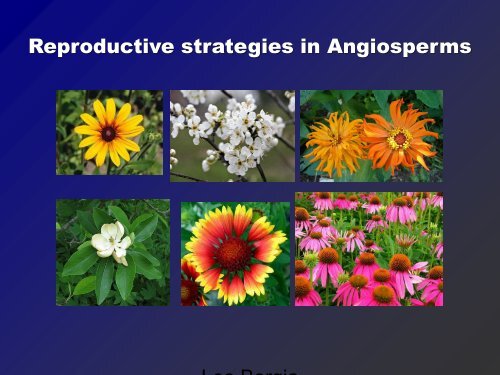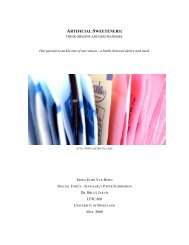Reproductive strategies in Angiosperms
Reproductive strategies in Angiosperms
Reproductive strategies in Angiosperms
Create successful ePaper yourself
Turn your PDF publications into a flip-book with our unique Google optimized e-Paper software.
<strong>Reproductive</strong> <strong>strategies</strong> <strong>in</strong> <strong>Angiosperms</strong>
Overview<br />
●<br />
●<br />
●<br />
●<br />
Self Incompatibility and changes <strong>in</strong> a mat<strong>in</strong>g<br />
system<br />
Types of mixed reproduction <strong>strategies</strong><br />
Obligate apomicts<br />
How plants enforce outcross<strong>in</strong>g
Mechanisms to promote<br />
Outcross<strong>in</strong>g<br />
●<br />
●<br />
●<br />
●<br />
Dioecy – separation of sexes between<br />
<strong>in</strong>dividual plants, not hermaphrodite.<br />
Self <strong>in</strong>compatibility – sometimes too effective<br />
Dichogamy – Male and Female reproductive<br />
parts mature asynchronously<br />
Herkogamy – Spatial separation of sex parts
Arabidopsis Lyrata<br />
●<br />
●<br />
●<br />
●<br />
Normally a genetically SI obligate outcrosser<br />
Shift <strong>in</strong> mat<strong>in</strong>g system resulted <strong>in</strong> loss of<br />
heterozygosity<br />
Low population density and poll<strong>in</strong>ator scarcity drive<br />
loss of SI system<br />
SI will evolve with high <strong>in</strong>breed<strong>in</strong>g depression
Why mixed reproduction?<br />
●<br />
●<br />
●<br />
●<br />
Perennials have more opportunities to outcross<br />
Resource allocation depends on environment<br />
Most species are hermaphroditic<br />
High seed set versus Inbreed<strong>in</strong>g depression
Viola lanceolata<br />
●<br />
●<br />
●<br />
●<br />
Mixed breed<strong>in</strong>g with two flower types<br />
Either Outcross<strong>in</strong>g chasmogamous flowers or<br />
self<strong>in</strong>g cleistogamous flowers<br />
Tradeoff between two types<br />
Chasmogamy results from favorable<br />
(Cortes 2006)<br />
environmental factors.
Bulb<strong>in</strong>e vagans<br />
●<br />
●<br />
●<br />
●<br />
●<br />
Hermaphroditic flowers accessible to bees<br />
Spatial separation of pistils and stamens<br />
Sex parts fold together when flower expires<br />
Inbreed<strong>in</strong>g depression observed<br />
<strong>Reproductive</strong> assurance without wast<strong>in</strong>g ovules<br />
(Vaughton 2007)
Evidence of Inbreed<strong>in</strong>g Depression
Taraxacum offic<strong>in</strong>ale<br />
●<br />
●<br />
●<br />
●<br />
Polyploid Amomicts<br />
Clonal reproduction results <strong>in</strong> highly<br />
homogeneous communities.<br />
Numerous hybridization events<br />
Asexual offspr<strong>in</strong>g from sexual parents<br />
(Majesky 2012)
Conclusion<br />
●<br />
●<br />
●<br />
●<br />
Both autogamy or self <strong>in</strong>compatibility will evolve<br />
under certa<strong>in</strong> conditions.<br />
Costs associated with reproduc<strong>in</strong>g sexually<br />
Mixed reproduction can be accomplished<br />
different ways.<br />
Asexual species arise from hybridization
Works Cited<br />
Majeský L, Vasut RJ, Kitner M, Trávnícek B. The pattern of genetic variability <strong>in</strong> apomictic clones of taraxacum offic<strong>in</strong>ale <strong>in</strong>dicates the<br />
alternation of asexual and sexual histories of apomicts. PLoS One. 2012;7(8).<br />
Aurea CC, Ballard,Harvey E.,,Jr. Influence of annual fluctuations <strong>in</strong> environmental conditions on chasmogamous flower production <strong>in</strong> viola<br />
striata1. J Torrey Bot Soc. 2006;133(2):312-320.<br />
Mable BK, Robertson AV, Dart S, Berardo CD, Witham L. Breakdown of self-<strong>in</strong>compatibility <strong>in</strong> the perennial ArabidopsisLyrata (brassicaceae)<br />
and its genetic consequences. Evolution. 2005;59(7):1437-1448. http://search.proquest.com/docview/55590502?accountid=14696. doi:<br />
http://dx.doi.org/10.1043/0014-3820(2005)059[1437:BOSITP]2.0.CO;2.<br />
Porcher E, Lande R. Loss of gametophytic self-<strong>in</strong>compatibility with evolution ofInbreed<strong>in</strong>g depression. Evolution. 2005;59(1):46-60.<br />
http://search.proquest.com/docview/55697690?accountid=14696. doi: 2.0.CO;2" TARGET="_blank">http://dx.doi.org/10.1043/0014-<br />
3820(2005)0592.0.CO;2<br />
Vaughton G, Ramsey M, Simpson I. Does self<strong>in</strong>g provide reproductive assurance <strong>in</strong> the perennial herb bulb<strong>in</strong>e vagans (asphodelaceae)? Oikos.<br />
2008;117(3):390-398. http://search.proquest.com/docview/211499354?accountid=14696. doi: http://dx.doi.org/10.1111/j.2007.0030-<br />
1299.16365.x. .




